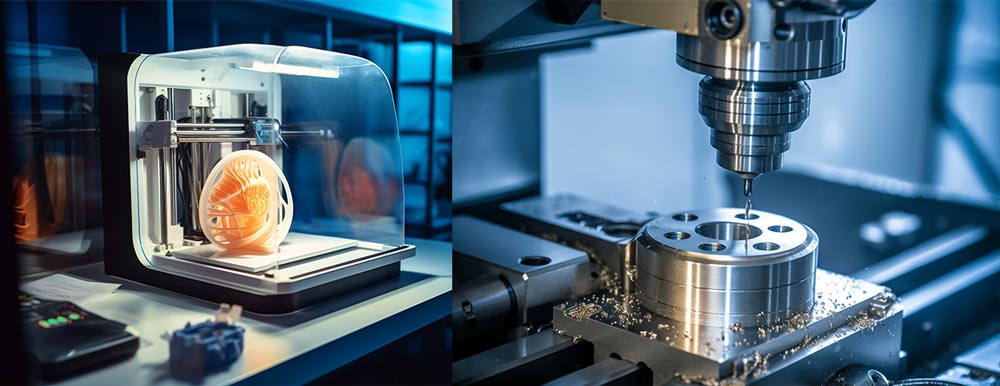The difference between 3D printing and CNC machining
1. Differences in materials
The main materials for 3D printing include liquid resin (SLA), nylon powder (SLS), metal powder (SLM), gypsum powder (full-color printing), sandstone powder (full-color printing), wire (DFM), and sheet (LOM) etc. Liquid resin, nylon powder and metal powder occupy the vast majority of the industrial 3D printing market.
The materials used for CNC precision machining are all pieces of plates, which are plate-shaped materials. By measuring the length, width and height + loss of the parts, plates of corresponding sizes are cut for processing. 2F Prototypes Precision is a machining factory with more than ten years of CNC processing experience. It has complete equipment, CNC turning/milling/grinding/drilling/processing. Partners with parts processing needs are welcome to call us for quotations.
CNC machining materials have more choices than 3D printing. General hardware and plastic sheets can be CNC machined, and the density of molded parts is better than that of 3D printing.
2. Differences in parts due to molding principles
Since 3D printing is a kind of additive manufacturing, its principle is to cut the model into N layers/N multi-points, and then stack them layer by layer/point by point in order, just like building blocks. Therefore, 3D printing can effectively process and produce parts with complex structures, such as hollow parts, while CNC is difficult to process hollow parts.
CNC machining is subtractive manufacturing. It uses various tools running at high speed to cut out the required parts according to the programmed tool path. Therefore, CNC precision machining can only process rounded corners with a certain arc, but cannot directly process internal right angles. This must be achieved through wire cutting/sparking and other processes. CNC machining of outer right angles is no problem. Therefore, 3D printing can be considered for parts with internal right angles. There are also curved surfaces. If the part has a large surface area, it is recommended to choose 3D printing. CNC machining of curved surfaces is very time-consuming, and if the programming and machine operation master is not experienced enough, it is easy to leave obvious lines on the parts.
No wonder some people say that 3D printing uses cake flour to pile up a cake, while CNC cuts a big cake into small cakes. This is really simple and easy to understand.
3. Differences in operating software
Most 3D printing slicing software is easy to operate. Even a layman can become proficient in operating the slicing software in a day or two with professional guidance. Because the slicing software is currently optimized to be very simple, supports can be automatically generated, which is why 3D printing can be popularized by individual users.
CNC programming software is much more complicated and requires professionals to operate it. People with zero basic knowledge usually need about half a year to learn it. In addition, a CNC machine operator is needed to operate the CNC machine. The more commonly used ones are UG, MASTERCAM, and CIMATRON. Learning these software is still difficult. 2F Prototypes has long been committed to the processing of high-precision, highly difficult, and easily deformable metal and plastic parts, small and medium-volume production and manufacturing of lightweight alloy and composite material (such as aluminum alloy, carbon fiber, etc.) parts, and robot parts procurement and customization services.
Because programming is very complex, a component can have many CNC processing solutions, while 3D printing only has a small impact on processing time and consumables due to placement, which is relatively objective.
4. Differences in surface finish
There are not many post-processing options for 3D printed parts, which generally include grinding, oil spraying, deburring, dyeing, etc.
There are various post-processing options for CNC machined parts, including grinding, oil spraying, deburring, electroplating, silk screen printing, pad printing, metal oxidation, laser engraving, sand blasting, etc.
There is a certain order of learning and there is a specialization in the art. CNC machining and 3D printing each have their own pros and cons. Choosing the right processing technology plays a vital role in your prototype project.

